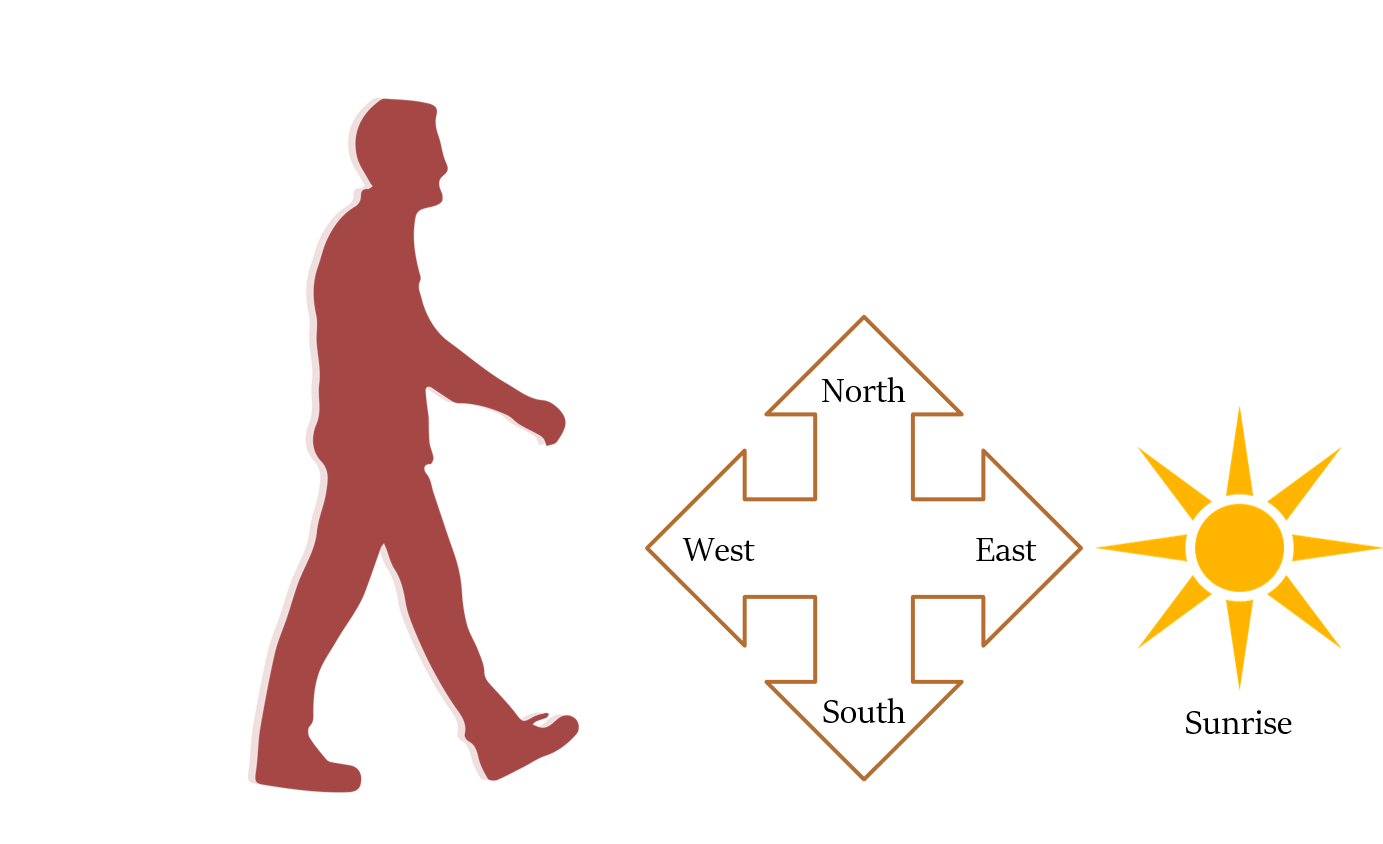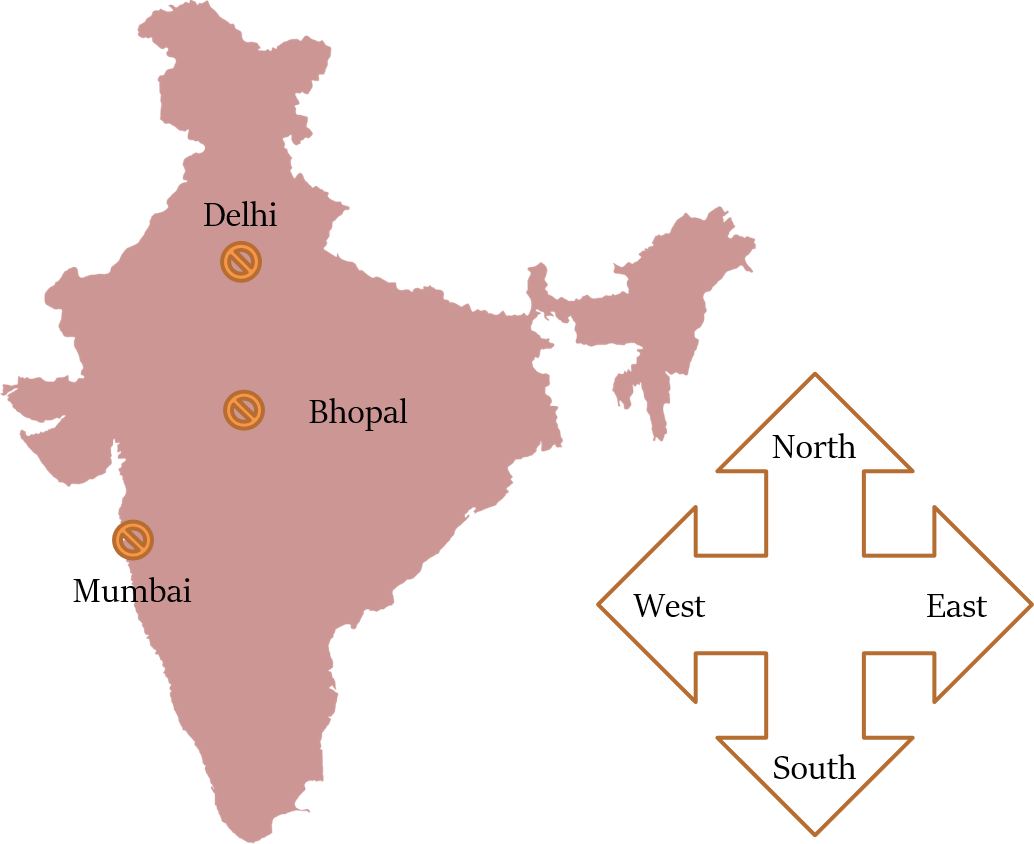Direction
Basic Introduction
In the ancient times, humans used to keep track of direction using primarily the position of the Sun or the Pole Star.
Sun is the most common used reference point to find directions. We know that the sun rises in the east and sets in the west.
Eight Directions
There are 8 directions that we need to know while solving questions based on directions.
There are four main directions / prime directions - North, South, East and West, based on the position of the sun, as shown below:
 The angle between any two adjacent prime directions is $90^o$.
The angle between any two adjacent prime directions is $90^o$.There are four sub-directions / cardinal directions too — North-East (N-E), North-West (N-W), South-East (S-E), and South-West (S-W).
The angle between any two adjacent sub-directions is $90^o$.
Angle formed between a prime direction and a sub-direction is $45^o$.
These directions are absolute directions, as they are with respect to the Sun and do not change with respect to the position of a person.
Note: These directions will be enough for any of our movement on 2D surface of the Earth. But in rare questions involving 3D movement, we may have to use the upward and downward directions too.
Finding Absolute Direction
Absolute direction is with respect to the sun.
If we face the Sun when it rises, then our position is as follows:
 Direction towards our front = East
Direction towards our front = East
Direction towards our back = West
Direction towards our left hand = North
Direction towards our right hand = South
- Concept of opposite direction
East is opposite to West, North to South, North-East to South-West and so on.
E.g. If a person is facing the East and a person is coming from the opposite direction, then it means that the other person is walking towards the West direction.
Q. If A stands with his face towards north, in which direction will his left hand point?
(a) North-East (b) North (c) East (d) West
Explanation:
Answer: (d)
Q. If A stands on his head with his face towards north, in which direction will his left hand point?
(a) North-East (b) North (c) East (d) West
Explanation:
Answer: (c)
Finding Relative Direction
Relative direction is with respect to some other object/person/place on Earth.
Consider the map shown below:

In which direction is Delhi with respect to Bhopal?
Here you will have to differentiate between the reference point and the point which is our focus, i.e. the point whose relative direction we are supposed to find.
Question wants us to find the relative direction of Delhi, with respect to the reference point Bhopal. So, our answer will be - Delhi is to the North of Bhopal. (obviously Bhopal will be in the opposite direction, i.e. to the South of Delhi)
In which direction is Delhi with respect to Mumbai?
Focus point is Delhi and reference point is Mumbai. So, our answer will be - Delhi is to the North-East of Mumbai. (obviously Mumbai will be in the opposite direction, i.e. to the South-West of Delhi)
Concept of turn
Right Turn = Clockwise Turn
When a person takes a turn in the direction of motion of clock, then this turn is called right turn or clockwise turn.
Left Turn = Anti-clockwise Turn
When a person turns in a direction opposite to motion of a clock, then this turn is called left turn or anti-clockwise turn.
These points should also be noted:
- These directions change with respect to the position of the person (i.e. these are relative directions).
- The angle of turn is assumed to be right angle, i.e., $90^o$ (until and unless stated otherwise).
Let’s consider the example of a person moving towards the East:
If he takes a left turn, then he will start moving towards the North direction.
If he takes a right turn, then he will start moving towards the South direction.
If he takes $45^o$ right/clockwise turn, then he will start moving towards the South-East direction.
If he takes $135^o$ (i.e. $90^o$ + $45^o$) right/clockwise turn, then he will start moving towards the South-West direction.
If he takes $180^o$ right/clockwise turn (or left/anti-clockwise turn), then he will start moving towards the West direction, i.e. in the opposite direction. (it’s what soldiers do when given a command of about-turn)
If he takes $225^o$ (i.e. $180^o$ + $45^o$) right/clockwise turn, then he will start moving towards the North-West direction. It is the same as taking $135^o$ left/aniti-clockwise turn, as $225^o$ + $135^o$ = $360^o$.
If a person moving towards East takes $360^o$ right/clockwise turn or $360^o$ left/anti-clockwise turn, then the person will keep moving in the same direction, i.e. East.
For turns more than $360^o$, we can subtract $360^o$ from the turn degree to get the effective angle of turn.
For example, $450^o$ right turn ≡ $450^o$ - $360^o$ ≡ $90^o$ right turn.
Solution Tips
For solving the question, it’s preferable that you draw a diagram on the paper. It will not only help you to reach the answer quickly but will also help you avoid silly mistakes.
It’s best to make a diagram as quickly as possible on a paper while following the instructions given in the question. It’s not necessary to draw the diagram to the scale.
The most important thing to care about is the initial direction that the person starts towards and then trace the further movements.
In case the final direction is given instead of the initial direction, we can trace backwards.